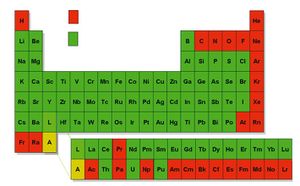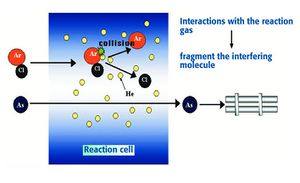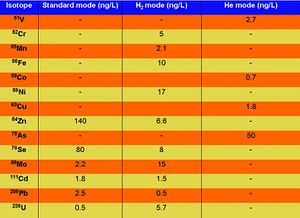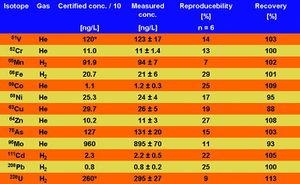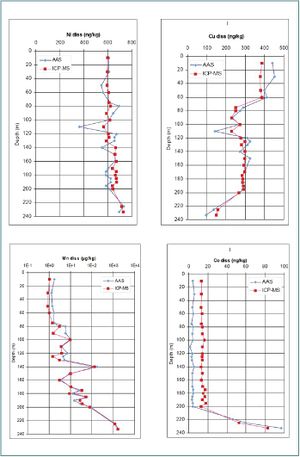Elemental mass spectrometry - a tool for monitoring trace element contaminants in the marine environment
Contents
Introduction
To understand the role and effects of trace elements and their species in marine ecosystems sensitive techniques are necessary to monitor their distribution between different environmental compartments. Since the beginning of industrialisation, anthrophogenic activities such as smelting, energy production, traffic, corrosion processes and landfill, and natural processes such as alteration, leaching or volcanism both influenced the specific distribution of trace elements within the marine environment.
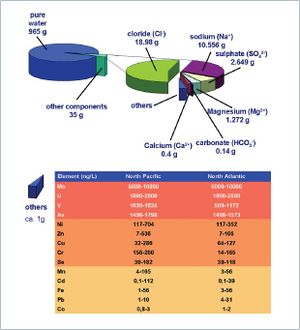
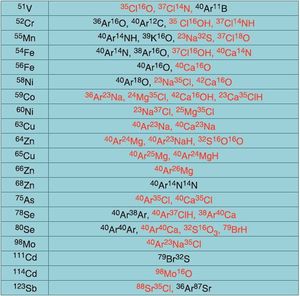
Challenges
Environmental samples such as seawater, biological fluids or tissues are complex mixtures. Often, they contain a few highly abundant elements (g l-1 level), which interfere with the sensitive determination of the remaining less concentrated elements (ng l-1 level) (Fig. 3). Established methodologies often require complex separation schemes to remove the interfering matrix compo- nents. Often, they are prone to errors and contamination, which leads to inaccurate results. Furthermore, most of them do not allow the simultaneous determination of a set of elements.
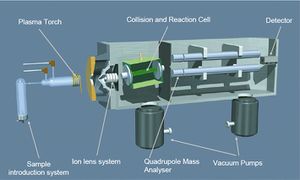
Methodology
To overcome these limitations, a method based on elemental mass spectrometry, namely the collision/reaction cell inductively coupled plasma mass spectrometry (CC-ICP-MS) has been developed (Fig. 4 and 5). It enables us to quantitatively determine a set of elements within a sample simultaneously (Leonhard et al., 2002[3]). Here, an inductively coupled argon plasma is used to dry and to destroy the sample matrix as well as to generate mainly singly charged element ions, which makes them detectable by mass spectrometry.
As shown in Fig. 2, ICP-MS allows the determination of nearly all relevant elements present in the periodic table with outstanding sensitivity and accuracy (Fig. 6 and 7).
Application fields
Vertical profiles in the Baltic Sea Within an intercalibration exercise, the collision/reaction cell ICP-MS method has been compared with an analytical method for trace element determination in seawater, which is based on a complex chemical matrix separation strategy and atomic absorption spectro- scopy (AAS). For ICP-MS measurements the samples were only acidified and diluted ten times with ultra pure water. The results of both methods were in good agreement, which indicates the potential of the developed methodology for the fast and reliable multi-element analysis of seawater samples.
Metal body burdens in seals
Even though the original collision/reaction cell ICP-MS was developed for trace element analysis of marine water samples, it is easily adapted to new tasks such as the determination of metal body burdens of marine mammals. As part of the monitoring of the health status of marine mammals, trace element levels in blood and tissue samples are under investigation, using ICP-MS for a reliable multi-element screening. The concentrations of selected elements were measured in fresh whole blood samples of 80 harbour seals, captured at three different locations of the German and Danish Wadden Sea.
For essential elements, such as calcium, iron or zink, low variations in the concentration level (12-25%) were observed due to their homeostatic regulation. Also no significant relation with gender, age or locality has been observed, and the levels were in the same order of magnitude as in humans.
In contrast, the level of trace elements shows a much wider variation of 30-287%.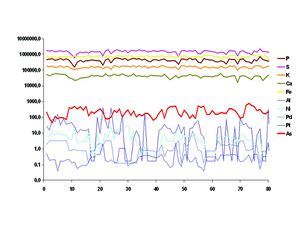
Furthermore, differences between sampling sites in the North Sea have been observed and could be explained by geographical variation of differently contaminated prey. In comparison with other trace elements, especially high arsenic concentrations have been observed (Griesel et al., 2008[4]).
Outlook
These examples show the potential of elemental mass spectrometry for the investigation of trace elements in the marine environment. Beside the amount of an element, also its chemical form (speciation) is of great importance, especially for its toxicity and, accordingly possible effects in the marine environment. CC-ICP-MS can be readily combined with chromatographic separation techniques allowing the investigation of relevant element species such as organotin, mercury or lead compounds.
See also
Wikipedia article on mass spectrometry
References
- ↑ Grasshoff, K., Ehrhardt, M., Kremling K. (1999). Methods of seawater analysis, Verlag Wiley-VCH, Weinheim 1999, ISBN 9783527295890.
- ↑ Kakuschke, A., Valentine-Thon, E., Griesel, S., Fonfara, S., Siebert, U. & Prange, A. (2005). The immunological impact of metals in Harbor Seals (Phoca vitulina) of the North Sea. Environmental Science & Technology, 39 (19), 7568-7575.
- ↑ Leonhard, P., Pepelnik, R., Prange, A., Yamada, N. & Yamada, T. (2002). Analysis of diluted sea- water at the ng L-1 level using an ICP-MS with an octopole reaction cell. Journal of Analytical Atomic Spectrometry, 17, 189-196.
- ↑ Griesel, S., Kakuschke, A., Siebert, U. & Prange, A. (2008). Trace element concentrations in blood of harbor seals (Phoca vitulina) from the Wadden Sea. Science of the Total Environment, 392 (2-3), 313-323.
Please note that others may also have edited the contents of this article.
|
